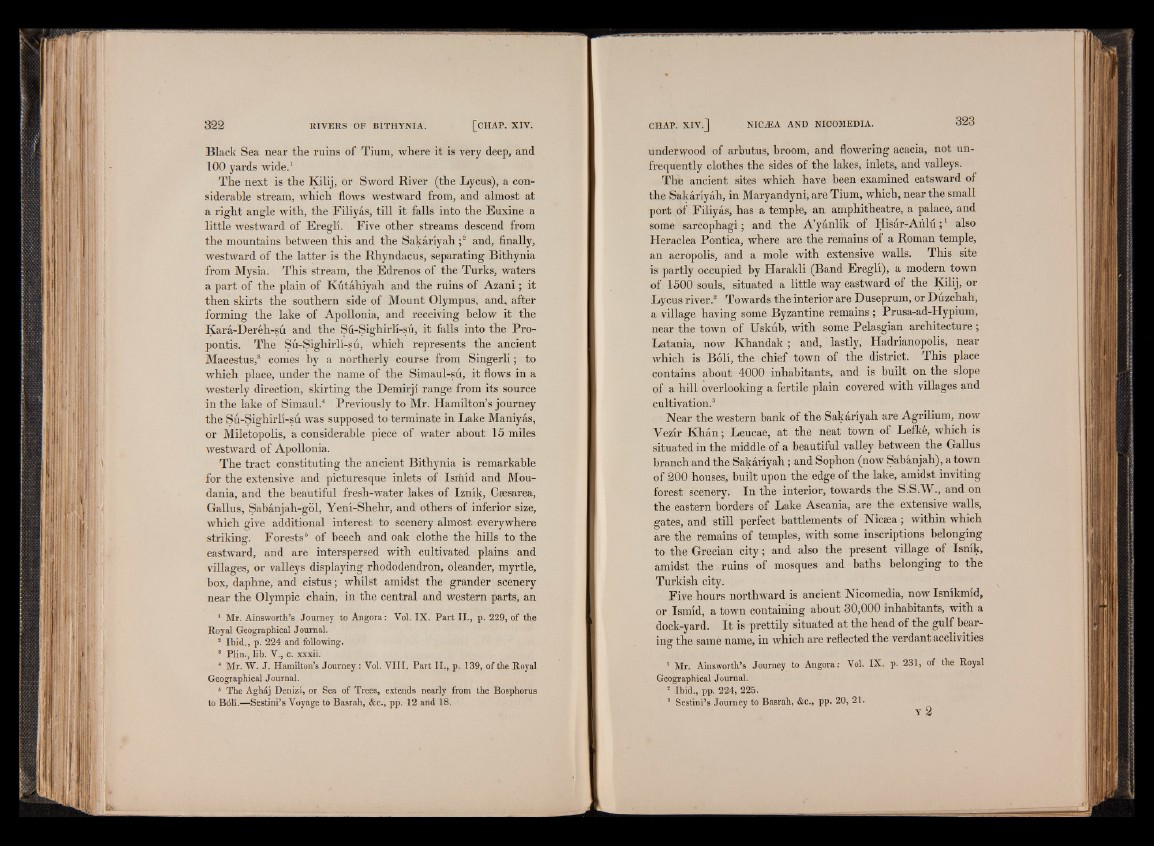
Black Sea near the ruins of Tium, where it is very deep, and
100 yards wide.1
The next is the Kilij, or Sword River (the Lycus), a considerable
stream, which flows westward from, and almost at
a right angle with, the Filiyas, till it falls into the Euxine a
little westward of Eregli. Five other streams descend from
the mountains between this and the Sakariyah ;2 and, finally,
westward of the latter is the Rhyndacus, separating Bithynia
from Mysia. This stream, the Edrenos of the Turks, waters
a part of the plain of Kutahiyah and the ruins of Azani; it
then skirts the southern side of Mount Olympus, and, after
forming the lake of Apollonia, and receiving below it the
Kara-I)ereh-su and the Su-Sighirli-su, it falls into the Propontis.
The Su-Sighirli-su, which represents the ancient
Macestus,3 comes by a northerly course from Singerli; to
which place, under the name of the Simaul-su, it flows in a
westerly direction, skirting the Demirji range from its source
in the lake of Simaul.4 Previously to Mr. Hamilton’s journey
the Su-Sighirli-su was supposed to terminate in Lake Maniyas,
or Miletopolis, a considerable piece of water about 15 miles
westward of Apollonia.
The tract constituting the ancient Bithynia is remarkable
for the extensive and picturesque inlets of Ismid and Mou-
dania, and the beautiful fresh-water lakes of Iznik, Caesarea,
Gallus, Sabanjah-gol, Yeni-Shehr, and others of inferior size,
which give additional interest to scenery almost everywhere
striking. Forests5 of beech and oak clothe the hills to the
eastward, and are interspersed with cultivated plains and
villages, or valleys displaying rhododendron, oleander, myrtle,
box, daphne, and cistus; whilst amidst the grander scenery
near the Olympic chain, in the central and western parts, an
1 Mr. Ainsworth’s Journey to Angora: Vol. IX. Part II., p. 229, of the
Royal Geographical Journal.
2 Ibid., p. 224 and following.
8 Plin., lib. V., c. xxxii.
4 Mr. W. J. Hamilton’s Journey : Vol. V III. Part II., p. 139, of the Royal
Geographical Journal.
5 The Aghdj Denizi, or Sea of Trees, extends nearly from the Bosphorus
to Bdli.—Sestini’s Voyage to Basrah, &c., pp. 12 and 18.
undervvood of arbutus, broom, and flowering acacia, not un-
frequently clothes the sides of the lakes, inlets, and valleys.
The ancient sites which have been examined eatsward of
the Sakariyah, in Maryandyni, are Tium, which, near the small
port of Filiyas, has a temple, an amphitheatre, a palace, and
some sarcophagi; and the A’yanlik of Hisar-Anlu;1 also
Heraclea Pontica, where are the remains of a Roman temple,
an acropolis, and a mole with extensive walls. This site
is partly occupied by Harakli (Band Eregli), a modern town
of 1500 souls, situated a little way eastward of the Kilij, or
Lycus river.2 Towards the interior are Duseprum, or Duzchah,
a village having some Byzantine remains; Prusa-ad-Hypium,
near the town of Uskub, with some Pelasgian architecture ;
Latania, now Khandak; and, lastly, Hadrianopolis, near
which is Boli, the chief town of the district. This place
contains about 4000 inhabitants, and is built on the slope
of a hill overlooking a fertile plain covered with villages and
cultivation.3
Near the western bank of the Sakariyah are Agrilium, now
Vezir Khan; Leucae, at the neat town of Lefke, which is
situated in the middle of a beautiful valley between the Gallus
branch and the Sakariyah; and Sophon (now Sabanjah), a town
of 200 houses, built upon the edge of the lake, amidst inviting
forest scenery. In the interior, towards the S.S.W., and on
the eastern borders of Lake Ascania, are the extensive walls,
gates, and still perfect battlements of Nicsea ; within which
are the remains of temples, with some inscriptions belonging
to the Grecian city; and also the present village of Isnik,
amidst the ruins of mosques and baths belonging to the
Turkish city.
Five hours northward is ancient Nicomedia, now Isnikmid,
or Ismid, a town containing about 30,000 inhabitants, with a
dock-yard. It is prettily situated at the head of the gulf bearing
the same name, in which are 0 reflected the verdant acclivities
1 Mr. Ainsworth’s Journey to Angora: Vol. IX. p. 231, of the Royal
Geographical Journal.
8 Ibid., pp. 224, 225.
3 Sestini’s Journey to Basrah, &c., pp. 20, 21.
Y 2